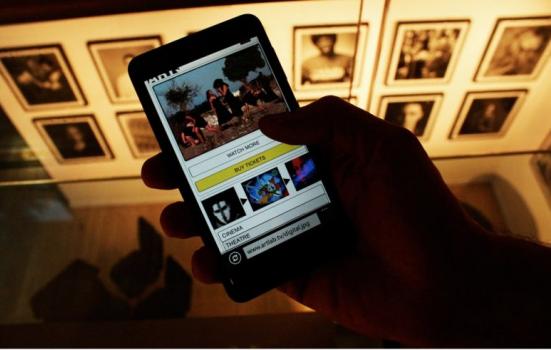Ali Hossaini believes that arts venues need to prepare for ‘digital placemaking’ by extending their use of in-house WiFi.

Leslie Cummins
Digital technology has come quietly to the arts. But it is not a time for complacency. The lesson from other sectors – music to banking to retail – is clear. Digital evolution shifts rapidly to digital revolution and the stakes for culture could not be higher. As we invest in digital platforms, we should consider the ‘clicks not bricks’ logic that drives them. Digital technologies flatten the competitive landscape, which opens the door to new talent. But the resulting ecology also removes local advantage. By lowering natural barriers, efficient digital networks encourage the dominance of megabrands. Amazon and a handful of other companies are undermining the diversity of the high street. Could we face a similar situation in the arts?
In the near future, audiences may be able to watch almost any film on a life-sized monitor with life-like qualities – giant curved TVs with ultra-high resolution are in the home market. The same device could deliver NT Live, the Metropolitan Opera and the latest exhibits at the Tate Modern, British Museum and V&A. Surely audiences deserve the world’s best talent. But what happens when the best dominate? Creativity suffers along with diversity. Art is like sport – it benefits to participate as well as spectate.
In-house WiFi channels could hand audiences seamlessly to live performances and the web, blending physical and virtual experiences
So far, arts organisations have adapted to digital technology by going online. But the web is a big place where audiences are hard to find. Marketing imperatives are driving public arts content to Facebook, Twitter and YouTube – firms driven by profit not mission. Almost perversely, individual empowerment creates an online ecology that favours a few large commercial brands. Social media drives aggregation of content, audiences and customers, and aggregation drives consolidation.
How can the arts benefit from digital technology? Equally important, how can the arts exercise leadership? The former relies on adaptation – a process which is underway – but the latter relies on innovation. To state the obvious, innovation is doing what has not been done before. Where can the arts blaze trails? Ideally through a terrain that plays to their advantage.
Three factors stand out: mobile, social and place. Mobility is well-established, but it has far to go before innovation plateaus. One day online may simply dissolve into mobile. Social applications underlie many disruptive technologies, and their potential for audience-facing organisations is clear. Place may be the most unique strength of the arts. Venues for music, dance, theatre and visual art represent hundreds of millions of pounds in public investment. By developing these three factors, arts venues could lead the next wave of convergence and they could introduce a new medium for engaging audiences: digital placemaking.
What do we want from a digital place? Arts venues are often located in the centre of cities and in the hearts of audiences who visit them for excellence in curation, presentation and creativity. Unfortunately, many venues are behind the technology curve and they offer digital experiences that lag behind expectations. By creating digital places, arts venues can become ‘digital destinations’ that offer unique, leading-edge experiences.
The ingredients for digital placemaking are already in our hands. Audiences carry rich digital portals in their pockets and purses, and mobile devices are inherently social. What venues need is to create digital engagement in situ, and they possess the means to do so: in-house WiFi. At present WiFi is offered to visitors as a necessary free service. With a simple upgrade, it becomes a powerful tool for engaging audiences.
The travelling public are probably familiar with the WiFi splash screen that appears in Virgin trains and BT hotspots. Cultural venues should adopt the same technology to promote digital content in-house. Splash screens offer a distraction-free opportunity to address highly interested people in a ‘branded environment’, and mobility allows people to select, mark and share their experience.
Content would be available in every corner of a venue, and internal messaging – lobby screens, galleries and cinemas – would be coordinated with external messaging on websites, social media and aggregators like YouTube. Mobile would link the venue with the wider online world. Venues could create media channels that extend programming in every direction. Exhibition guides could include images, film clips and related works – available now and later. Trailers would promote upcoming films and performances, and venues could offer extended runs on video on demand (VOD). “Missed the latest film? Stream it for two more weeks in the venue café!”
But flexible, interactive content is only the beginning. Digital destinations could evolve into new platforms for artistic commissioning. Interactive work is an obvious choice, but artists, directors and curators may extend the boundaries of traditional artforms like cinema, theatre and dance. In-house WiFi channels could link audiences seamlessly to live performances and the web, blending physical and virtual experiences. Future narratives may extend for weeks around an event.
For the arts, digital leadership relies on a venue-centric strategy of ‘clicks and bricks’. Investments should be made in physical places – stages, cinemas, public areas – as well as virtual spaces. Digital placemaking could provide strategic guidelines for various strands of investment in cultural organisations. To use Paul Bennun’s words in Native, arts organisations should consider themselves part of “systems and platforms”. But digital leadership need not come at the expense of mission. Digital investments should be aligned with the fundamental goals of a venue, whether they be access, sustainability or creative commissioning.
By adding the unique ingredient of ‘place’ to digital strategy, the depth of national commissions can be combined with the breadth and localism of individual arts venues. Instead of pooling around limited audiences, investments in the arts – and great art itself – can resonate across a collaborative network that maximises their benefit for everyone.
Ali Hossaini is Chief Executive of Cinema Arts Network.
www.cinema-arts.net




